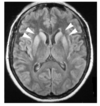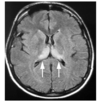Dementia Flashcards
(84 cards)
What is the definition of dementia?
a progressive and largely irreversible syndrome that is characterised by a widespread impairment of mental function
sufficiently severe to impair social and occupational functioning
What care needs are implicated in dementia?
dementia is associated with complex needs and high levels of dependency and morbidity
care needs often challenge the skills and capacity of carers and available services
What are the 6 types of neurodegenerative dementia?
Which is the most common and least common?
most common - Alzheimer’s disease
- vascular dementia
- mixed dementia
- lewy body disease
- fronto-temporal dementia
least common - Parkinson’s dementia
In which 3 ways can dementia be classified?
- site in the brain
- age
- pathology
What kind of symptoms are produced from disease of the frontal lobes?
it produces abnormalities in several behavioural domains
abnormality leads to impaired:
- judgement
- abstract reasoning
- strategic planning
- emotional restraint
- control of appetite and continence
What does disease of the medial temporal lobe, hippocampus, amygdala and limbic system lead to?
disorders of memory and hallucinations
What are the symptoms of disorders of the temporal neocortex?
receptive dysphasia and automatisms
What is receptive dysphasia and expressive dysphasia?
receptive dysphasia:
- difficulty in comprehension and understanding
- can speak words fluently, but they do not make sense
expressive dysphasia:
- difficulty putting words together to make meaning
- comprehension is intact
What symptoms arise due to disorders of the occipital lobe?
failure of the visual and sensory systems
What symptoms arise from disease of the parietal lobe?
Why do they occur?
impairment of visuospatial skills and integration of sensory inputs
this leads to sensory agnosias and apraxias

What is meant by an automatism?
an action that is performed unconsciously or involuntarily
What are the 4 categories of classification of dementia based on site?
- anterior
- posterior
- subcortical
- cortical
What are the symptoms of a condition affecting the anterior region?
What are examples of conditions which arise?
frontal premotor cortex
- behavioural changes / loss of inhibition
- antisocial behaviour
- facile and irresponsible
seen in normal pressure hydrocephalus, Huntington’s chorea and metabolic disease
What symptoms arise from a problem in the posterior region?
What condition results from this?
parietal and temporal lobes
- disturbance of cognitive function (memory & language) without marked changes in behaviour
seen in Alzheimer’s disease

What are the symptoms of a problem in the subcortial site?
What conditions results from this?
- apathetic
- forgetful and slow with poor ability to use knowledge
- associated with other neurological signs and movement disorders
seen in Parkinson’s disease and AIDS dementia complex

What are the symptoms associated with a problem in the cortical region?
higher cortical abnormalities including:
- dysphasia
- agnosia
- apraxia
this is seen in Alzheimer’s disease
What is meant by agnosia and apraxia?
agnosia:
- inability to interpret sensations and recognise things
apraxia:
- individual has difficulty with the motor planning to perform tasks or movements when asked
What is meant by young onset dementia?
a young onset age is < 65 years
it is not always memory that is affected
this may be genetic or metabolic
What types of dementia are present in people aged above and below 65?
age above 65:
- alzheimer’s
- vascular
- lewy body
age less than 65:
- alzheimer’s
- vascular
- fronto-temporal
What are the three categories in the molecular-genetic classification of neurodegenerative diseases?
tauopathies:
- characterised by neuronal and/or glial inclusions composed of the microtubule-binding protein, tau
synucleinopathies:
- characterised by abnormal accumulation of aggregates of alpha-synuclein protein in neurones, nerve fibres or glial cells
ubiquinopathies:
What are examples of tauopathies?
- FTD and FTDP-17
- progressive supranuclear palsy (PSP)
- corticobasal degeneration
- Alzheimer’s disease
What are examples of synucleinopathies?
- parkinson’s disease
- dementia with lewy bodies
- multiple system atrophy (MSA)
What are examples of ubiquinopathies?
- motor neurone disease (MND) and MND / dementia
- semantic dementia








